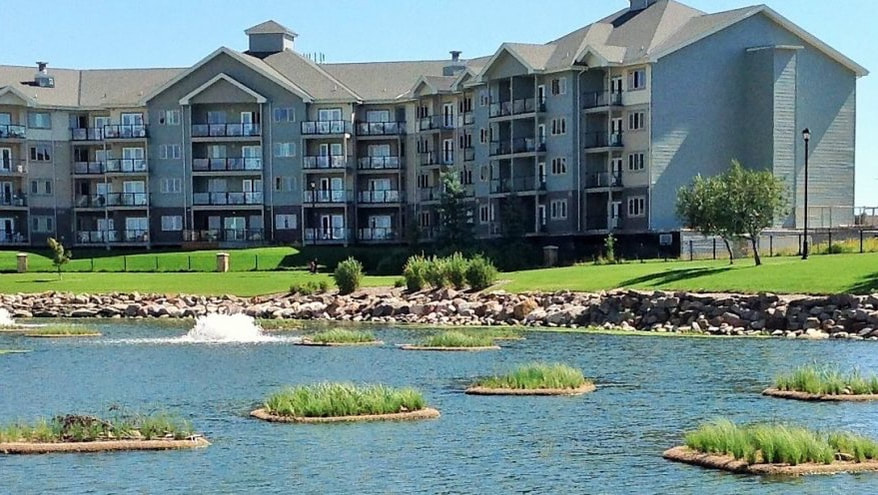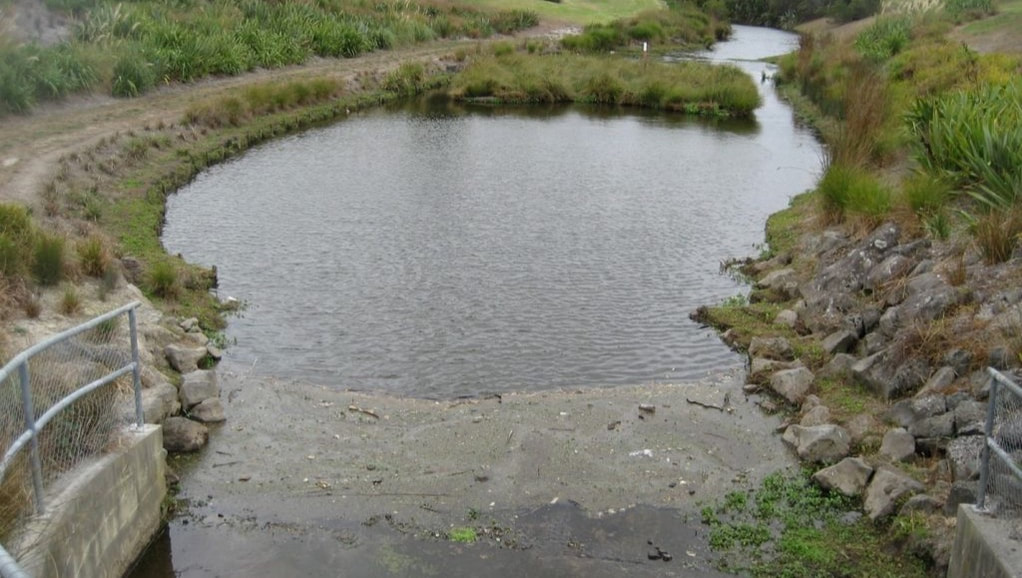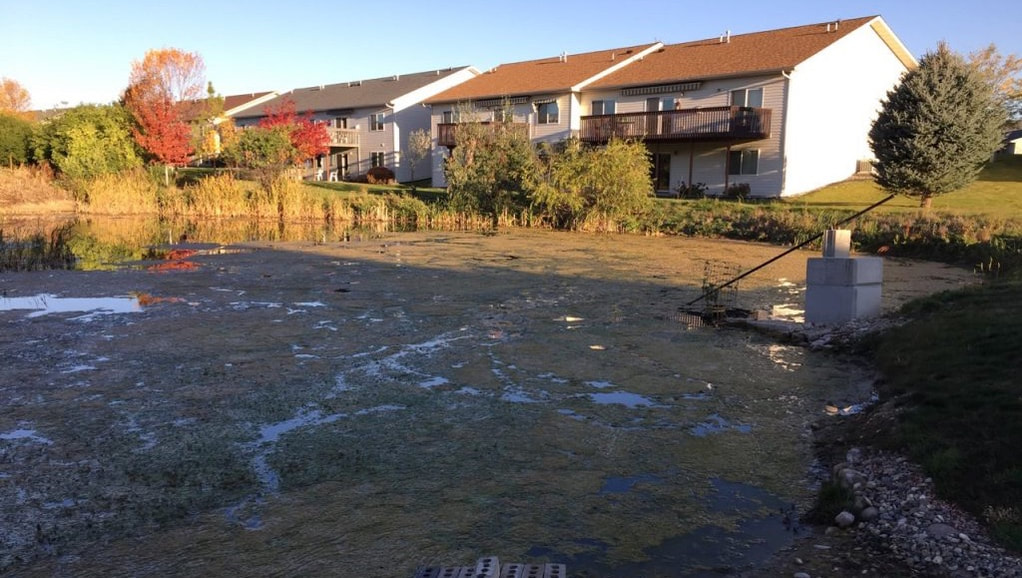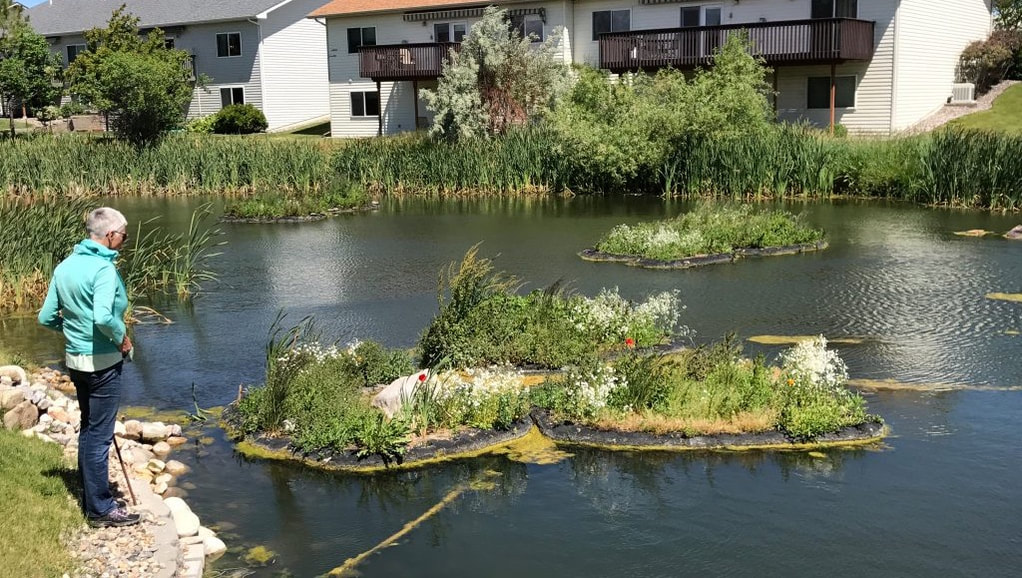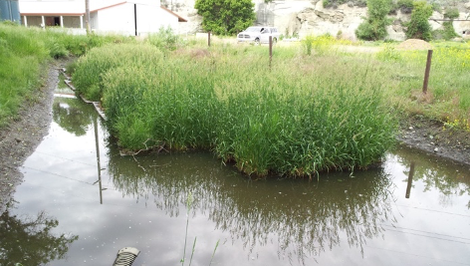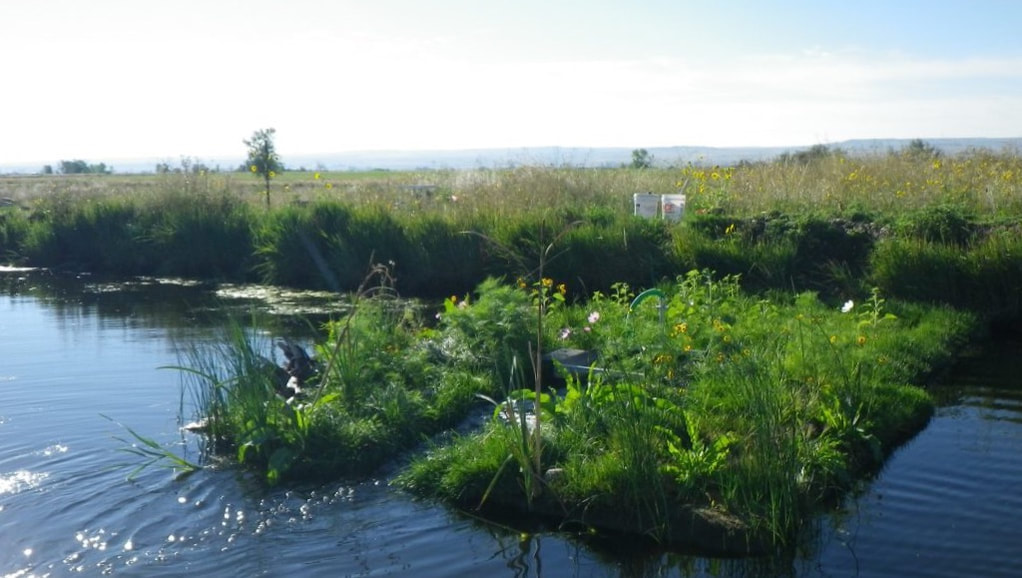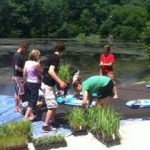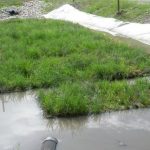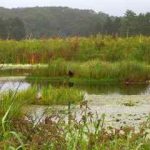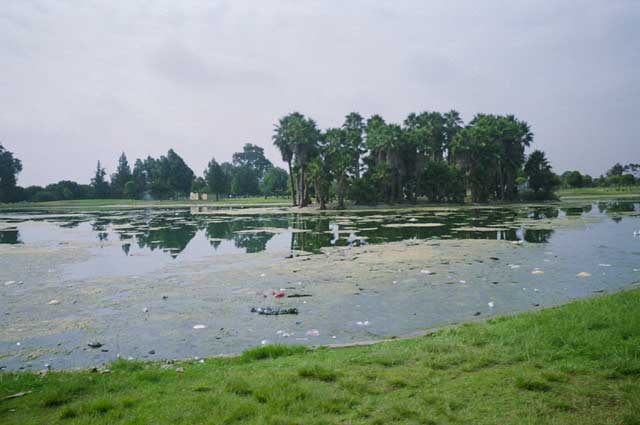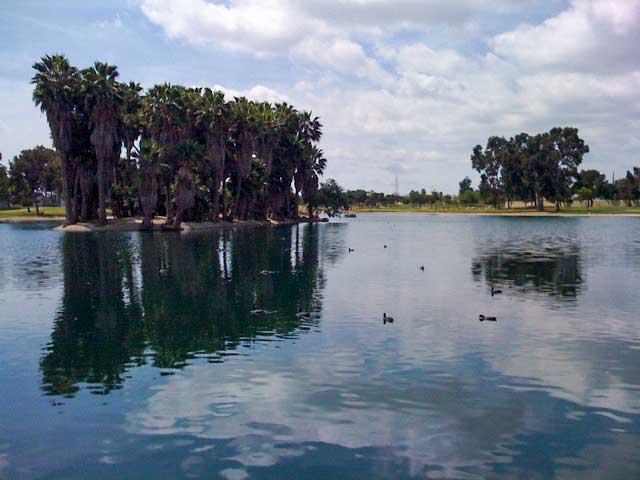For stormwater management, BioHaven floating islands efficiently treat runoff while delivering quality-of-life benefits.They act like a natural wetland, increasing the aesthetic value and wildlife abundance of any stormwater pond and farm pond. Easily installed, they protect the environment from harmful pollutants and sediments carried downstream by urban, industrial and agricultural runoff. In many US states, BioHaven Floating Islands have been approved as a BMP and can be used to gain nutrient credits.
Floating Islands for Stormwater Management
How Scientists Describe Floating WetlandsBioHaven Floating Islands employ rooted, emergent macrophytes (similar to those used in surface and subsurface flow wetlands) growing as a floating mat on the surface of the water rather than rooted in the sediments. They tolerate wide fluctuations in water depths that are typical of stormwater systems. The plant roots hanging beneath the island provide a large surface area for biofilm growth and entrapment of fine suspended particulates that would otherwise remain in suspension in a pond system. Because the plants are not rooted in the sediment, they are forced to acquire their nutrition directly from the water column, which enhances potential rates of nutrient and element uptake into biomass.
It’s all about the matrix
The heart of the BioHaven solutions is the permeable, tiny fibers of the proprietary matrix, together with mature plants and extensive roots that grow through them. Together, they make up a massive surface area that supports the growth of biofilm, a sticky substance that contains the microbes responsible for treating pollutants in stormwater. Through the processes of organic digestion, particle settlement, filtration, adsorption and direct uptake, BioHavens can treat oil and grease, excess nutrients and heavy metals such as copper and zinc. Put another way, pollutants are circulated through the islands and glom on to the sticky biofilm covering the root surfaces and island matrix. They either fall off into the sediments below when they get too heavy or are digested by the incredible food web inside the island and the plant-root mass. Minimal Environmental Impact BioHaven treatment approach to stormwater management requires zero land use, and has many other environmental benefits:
|
|
Not all stormwater is created equal. Just look up-watershed and track the potential nutrient loading that is no doubt happening. For example, is there farming in the up-watershed region? In such a setting there are likely to be surges of nutrients. Say a storm event coincides with farm field fertilizer application. Or a flood irrigation system overflows. About a million other mishaps can explain the occasional burst of phosphorus and nitrogen, which can turn the downstream stormwater pond into a carpet of algae. The intermittent nature of these events, and their indirect source, can make stormwater management particularly challenging.
Treatment Benefits
BioHaven Floating Islands can effectively treat ponds, streams and ditches to restore a watershed to health:
BioHaven Floating Islands can effectively treat ponds, streams and ditches to restore a watershed to health:
- Effectively reduce algae blooms, cyanobacteria and Golden Algae
- Reduction in phosphorus and nitrogen halts widespread loss of aquatic life
- Reduction in fecal coliforms makes water healthier for humans and animals to drink
- Sediment trapping and removal prevents choking of pristine waters
- Prevention of erosion maintains stream and river bank integrity
- Prevention of midgefly, mosquito, and other nuisance pest infestation
Case Studies & Research
Mermaid Pool: Passive Biohavens remove phosphorus in a New Jersey stormwater pond
BioHavens north of Chicago win storm water BMP award for local conservation group
What do Los Angeles County water managers know about cleaning water?
In May 2014, two 65 sq. ft. BioHaven Floating Islands were launched on Magic Johnson Lake.
The islands were planted with a carefully selected list of plants for phytoremediation. The islands were placed in the path of the current that contained the algae bloom. A pump with a drip system was affixed, and took-up the water from the current, distributing it evenly throughout the matrix of the island. Combined with the roots of the plant, the island’s dense fibers and porous texture provided a perfect habitat for periphyton and beneficial microbial colonization. Periphyton absorbs contaminants, removing them from the water column and limiting their movement through the environment. After the installation, the water manager (AquaBio) began the application of bioaugmentation. The islands were successful at harboring a dynamic environment for beneficial microbes and plants used for the degradation of water contaminants. Furthermore, they helped in carbon sequestration and absorption of greenhouse gasses. After a year, the islands were fully established. The vegetation was blooming while the condition of the water was restored to a healthy balance for its inhabitants.
There was an immediate decline in the ammonia content of the water: from 0.28 mg/l on May 2, to 0.1 on July 8.
Fecal Coliform was measured at 300 mpn/100ml on April 10, 2015.
On September 1 of that year, it was measured at 130 mpn/100ml.
On January 18, 2016, fecal coliform was measured at 23 mpn/100ml.
And by July 1, 2016, it had dropped to 2/mpn/100ml.
The islands were planted with a carefully selected list of plants for phytoremediation. The islands were placed in the path of the current that contained the algae bloom. A pump with a drip system was affixed, and took-up the water from the current, distributing it evenly throughout the matrix of the island. Combined with the roots of the plant, the island’s dense fibers and porous texture provided a perfect habitat for periphyton and beneficial microbial colonization. Periphyton absorbs contaminants, removing them from the water column and limiting their movement through the environment. After the installation, the water manager (AquaBio) began the application of bioaugmentation. The islands were successful at harboring a dynamic environment for beneficial microbes and plants used for the degradation of water contaminants. Furthermore, they helped in carbon sequestration and absorption of greenhouse gasses. After a year, the islands were fully established. The vegetation was blooming while the condition of the water was restored to a healthy balance for its inhabitants.
There was an immediate decline in the ammonia content of the water: from 0.28 mg/l on May 2, to 0.1 on July 8.
Fecal Coliform was measured at 300 mpn/100ml on April 10, 2015.
On September 1 of that year, it was measured at 130 mpn/100ml.
On January 18, 2016, fecal coliform was measured at 23 mpn/100ml.
And by July 1, 2016, it had dropped to 2/mpn/100ml.
Urban stormwater poses significant threats to waterways because it transports pollutants.
Urban pollutant loading, caused by nutrients, heavy metals, sediment, indicator organisms, and hydrocarbons, tends to be more complex and more toxic than rural pollution, where agricultural nutrient runoff is the main culprit. Both have a deadly effect on water.
In urban areas, the added volume of stormwater conveyed from impervious surfaces causes stream bank erosion, degradation of aquatic habitat, and loss of real estate. Therefore, federal, state, and local legislation in the U.S. mandates the use of stormwater control measures (SCMs) to combat these negative consequences of urban growth. Examples of SCMs include innovative stormwater practices, such as bioretention, permeable pavement, water harvesting, and infiltration devices, which are often integrated into Low Impact Development (LID) strategies.
Nutrient reduction goals have been set with strict TN (total nitrogen) and TP (total phosphorus) load limits for new and existing development. Since existing developments often have limited space for retrofitting stormwater practices, methods to improve currently in-ground stormwater practices’ performance for nutrient removal are crucial.
In 2006, a world-renowned New Zealand wetland scientist, Dr. Chris Tanner, saw the potential for using the new technology of Floating Treatment Wetlands for filtering out heavy metals from stormwater. Focusing on BioHavens, which he saw as “the next generation” of Floating Islands, Dr. Tanner published a series of studies, which were presented to several international gatherings of wetland scientists.
The first laboratory research he undertook (Tanner and Headley, 2008) showed positive removal of copper and zinc, in both particulate and dissolved form, and also showed significant removal of phosphate, nitrate, and ammonia. Other international research followed, inspired by the success of Tanner’s studies.
In urban areas, the added volume of stormwater conveyed from impervious surfaces causes stream bank erosion, degradation of aquatic habitat, and loss of real estate. Therefore, federal, state, and local legislation in the U.S. mandates the use of stormwater control measures (SCMs) to combat these negative consequences of urban growth. Examples of SCMs include innovative stormwater practices, such as bioretention, permeable pavement, water harvesting, and infiltration devices, which are often integrated into Low Impact Development (LID) strategies.
Nutrient reduction goals have been set with strict TN (total nitrogen) and TP (total phosphorus) load limits for new and existing development. Since existing developments often have limited space for retrofitting stormwater practices, methods to improve currently in-ground stormwater practices’ performance for nutrient removal are crucial.
In 2006, a world-renowned New Zealand wetland scientist, Dr. Chris Tanner, saw the potential for using the new technology of Floating Treatment Wetlands for filtering out heavy metals from stormwater. Focusing on BioHavens, which he saw as “the next generation” of Floating Islands, Dr. Tanner published a series of studies, which were presented to several international gatherings of wetland scientists.
The first laboratory research he undertook (Tanner and Headley, 2008) showed positive removal of copper and zinc, in both particulate and dissolved form, and also showed significant removal of phosphate, nitrate, and ammonia. Other international research followed, inspired by the success of Tanner’s studies.
Evaluation of Floating Wetland Islands (FWIs) as a Retrofit to Existing Stormwater Detention Basins, (2012) sponsored by North Carolina DENR was the first significant US study to provide data on the performance of BioHaven Floating Islands as a retrofit to stormwater wet ponds.
Principal investigator Professor Bill Hunt was interested in the Floating Islands because they 1) do not require earth moving, (2) they eliminate the need for additional land to be dedicated to treatment, and (3) will not detract from the required storage volume required for wet ponds (because they float). He studied two ponds, the DOT pond and the Museum pond with different sized island installations to evaluate the ideal amount of coverage required (and, consequently, associated nutrient credits). The results in both ponds showed “dramatic improvement,” in nitrogen especially, particularly in the Museum pond with the higher coverage.
Please request the full report here.
Scientists have continued to evaluate the specific wetland processes involved with floating wetlands, to understand in detail the effect of the islands as opposed to other factors. Our understanding—and with it, our ability to predict outcomes— continues to increase. Third-party case studies have continued to verify these results. Please see Mermaid Pool, Bribie Island, and Holly Pond.
Holly pond was an algae-covered mosquito factory prior to the installation of BioHaven Floating Islands and a Floating StreamBed. The City of Sheridan, WY, began to manage it as a minnow fishery pond that has been featured at the state pest control conference as an example of how to steward water to prevent mosquitoes.
Please request the full report here.
Please request the full report here.
Scientists have continued to evaluate the specific wetland processes involved with floating wetlands, to understand in detail the effect of the islands as opposed to other factors. Our understanding—and with it, our ability to predict outcomes— continues to increase. Third-party case studies have continued to verify these results. Please see Mermaid Pool, Bribie Island, and Holly Pond.
Holly pond was an algae-covered mosquito factory prior to the installation of BioHaven Floating Islands and a Floating StreamBed. The City of Sheridan, WY, began to manage it as a minnow fishery pond that has been featured at the state pest control conference as an example of how to steward water to prevent mosquitoes.
Please request the full report here.
Angelica Creek
The Angelica Creek Park restoration is a project designed to mitigate climate change by improving ecosystem functionality.
Angelica Creek, which had become clogged and stagnant, now flows, weaving between two wetlands. Cattails and other wet-loving plants flourish in the soggy soils while native trees and woody shrubs – sycamore, swamp white oak, and osier dogwood – have taken root along Angelica’s banks. These new plantings of native wetland and riparian plants provide rich wildlife habitat for birds, like the red-winged blackbird boldly belting its conk-la-ree melody, and mammals, like the red fox furtively tiptoeing through stands of tall, reedy grass.
This wetland nexus is also designed to collect and filter stormwater, an emerging challenge for streams as extreme weather events increase in frequency and the prevalence of paved surfaces across the watershed increases flooding volumes. Angelica Creek’s wetland complex includes a retention pond, upon which a Biohaven wetland island floats. Lush with native plants, the floating wetland recycles excess nutrients carried by stormwater that could otherwise sicken the stream. Since untreated nutrients can ultimately give off methane, the new wetland is not only a carbon sink but also reducing greenhouse gas emissions. Read more about Angelica Creek’s restoration, here!
Angelica Creek, which had become clogged and stagnant, now flows, weaving between two wetlands. Cattails and other wet-loving plants flourish in the soggy soils while native trees and woody shrubs – sycamore, swamp white oak, and osier dogwood – have taken root along Angelica’s banks. These new plantings of native wetland and riparian plants provide rich wildlife habitat for birds, like the red-winged blackbird boldly belting its conk-la-ree melody, and mammals, like the red fox furtively tiptoeing through stands of tall, reedy grass.
This wetland nexus is also designed to collect and filter stormwater, an emerging challenge for streams as extreme weather events increase in frequency and the prevalence of paved surfaces across the watershed increases flooding volumes. Angelica Creek’s wetland complex includes a retention pond, upon which a Biohaven wetland island floats. Lush with native plants, the floating wetland recycles excess nutrients carried by stormwater that could otherwise sicken the stream. Since untreated nutrients can ultimately give off methane, the new wetland is not only a carbon sink but also reducing greenhouse gas emissions. Read more about Angelica Creek’s restoration, here!
